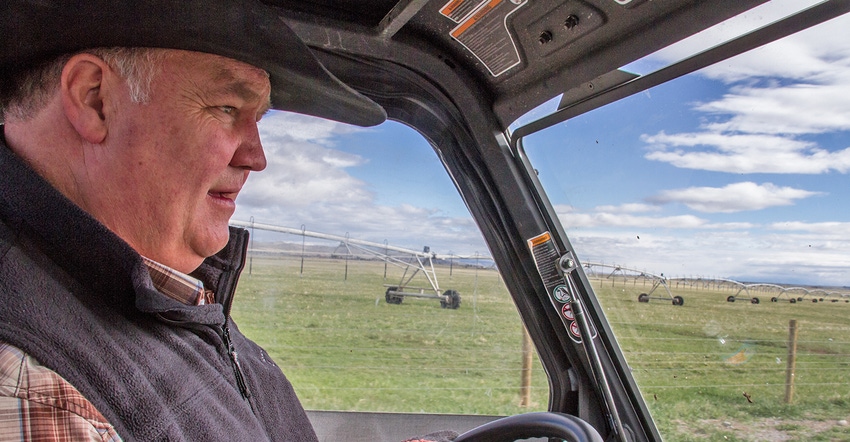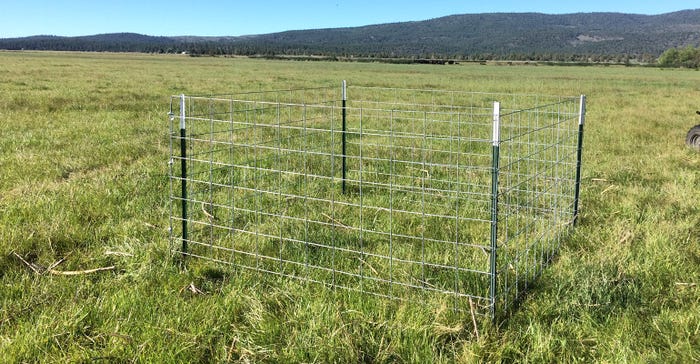December 24, 2018

Across the West, irrigated pastureland provides critical high-quality forage for the management of a cow-calf herd. Irrigated pasture ranks third — tree crops (almonds, pistachios, etc.) and alfalfa rate above it — on the California agriculture water use list. But irrigated pasture forage yield is estimated at as much as one-third of potential productivity. Persistent drought in California prompted Leslie Roche, University of California, Davis, Cooperative Extension specialist, to research a solution.
Roche assembled a network of producers and natural resources professionals from her base in Yolo County up to the Oregon state line. The project, now 2 years old, involves 23 ranchers, 33 monitoring sites and 4,000 acres of irrigated pasture.
Data collection is expansive: forage productivity, utilization, soil fertility and soil moisture conditions, biodiversity, and water use efficiency. “We’re looking at a gradient of pasture management strategies,” explains Roche, a specialist in rangeland science and management. “To increase productivity, we need to understand the integrated irrigation, grazing, hay harvest and nutrient management strategies that folks use.”

How productive is your pasture?
To judge pasture productivity, the project set up 33 grazing “exclosures.” Exclosures are fenced areas inside a working pasture that keep cattle out but show how the grasses perform under irrigation. Those exclosures were the first for many of the growers.
“For the first time, many are seeing the productivity of their pastures,” Roche says. “Our local farm adviser partners, who have worked in these areas for a long time, were surprised at the low levels of productivity. Some folks have now set aside pasture to try different grazing rotations.”
Irrigated pastureland is a vital resource for ranchers, because the dry season leaves significant gaps in abundant, high-quality forage. During drought, when dryland productivity is severely reduced, irrigated pastures are essential. Ranchers wonder if cattle grazing irrigated pastures too low in the autumn affects productivity in the spring.
To find an answer, Roche and her colleagues deployed clipping experiments. “We’re looking at different heights of fall defoliation to examine potential impacts on the following spring’s productivity,” Roche says of the method. “We see indications that higher defoliation pressure — lower plant height — reduces grass tiller production. Results also show decreases in total forage production, potentially due to impacts to meristems of plants that aren’t fully dormant. In much colder climates, where grasses do go fully dormant, grazing fall stubble is generally considered to not impact regrowth, and has, therefore, not been as much of a concern.”
The researchers did find evidence of microclimatic effects interacting with grazing pressure, especially in colder areas with snowfall. “If grazing removes vegetation down to the soil, the buds may be damaged by the cold,” Roche cautions. “We implemented a research trial looking at three different irrigated pasture species, so we can have more experimental control to verify those findings.”
Roche recommends leaving several inches of residual stubble in the cold season to support root and tiller production.

Graze it differently
Outside of Dillon, Mont., the La Cense Ranch uses its grass similarly to California ranchers. Its mother cows graze Bureau of Land Management rangeland in summer and deeded irrigated pastures in the autumn, winter and spring.
La Cense runs miles of electric fence across its irrigated acres to split pastures for rotating cattle daily. This is not only for efficient use of grass, but also for cattle performance. “Cows are more selective then a forage sampler,” says Race King, La Cense manager. “If we put cattle in a pasture for a month, in the first week those cows would only eat the best grass. We prevent this by rotating cows through smaller pastures to promote grazing of all grass species and a balanced diet.”
Irrigated pastures are rested in the grazing rotation to leave dormant grass standing for winter feed. Cows now calve later in the spring (mid-April to beginning of June), just as grass begins to green up. King counts calving on green grass as the most effective change for livestock health and finances.
“Backing up our calving dates lowered our labor,” he explains. “We don’t babysit the cows or heifers that much. It also gives us healthier calves because of warmer weather. The green grass means the cows don’t have to lactate for months on winter feed. A dry cow can maintain herself pretty well on dormant pasture. This helps us graze 12 months a year and lowers our operating costs.”
“We think of ourselves as resource managers,” King continues. “We just use cattle as a tool to harvest the grass product. On our irrigated ground, where there is same-season grass regrowth potential, we move cattle daily to gain more grass production per acre. We feel we’re better at doing that than farming [producing hay].”
Tighter pasture management
Leslie Roche’s team finds that most irrigated pastureland in Northern California is not fertilized. The exception is producers who graze and hay a field in the same season. Often, those folks use more precise irrigation systems and implement fertilization strategies.
“A lot of folks tend to be on the other end of management intensity from precision,” Roche says of data findings. “They flood-irrigate or wild-flood-irrigate. There are a lot of questions about if the investment in improving irrigation or renovating the pasture would actually be beneficial. The gradient of data will hopefully show what folks actually see in terms of benefit, and capture what causes it.”
Most irrigated pastures monitored haven’t been renovated in at least 20 years. Ranchers involved in the study, and across the state, requested recommendations on new forage species to plant. In response, UC Cooperative Extension and UC Davis researchers are launching trials of new tall fescue cultivars across various California ecoregions to examine their potential to provide a more reliable forage supply.
Until these trials are completed, Roche recommends, depending on the producer’s ecoregion, “the typical mix of perennial grasses like orchardgrass, tall fescue, or timothy and nitrogen-fixing forb species. In the next couple years, we’ll be ready to make more modern recommendations.”
Irrigation and forage quality
Continuous irrigation or frequent applications of excessive volumes reduce a pasture’s value for livestock production. Management determines soil moisture status and depth to water table on irrigated pastures. It is possible to have saturated soil conditions that persist for much of the irrigation season. As a result, plant communities may switch to wetland species, such as sedges and rushes. Compared to grasses and clovers, sedges and rushes hold low forage quality for livestock. Most high-forage-quality grasses and clovers cannot survive on sites with prolonged saturation.
Hemken writes from Lander, Wyo.
About the Author(s)
You May Also Like




